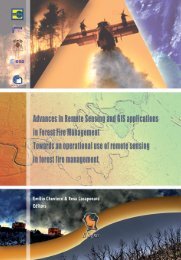Mapping microphytobenthos in the intertidal zone of Northern ...
Mapping microphytobenthos in the intertidal zone of Northern ...
Mapping microphytobenthos in the intertidal zone of Northern ...
You also want an ePaper? Increase the reach of your titles
YUMPU automatically turns print PDFs into web optimized ePapers that Google loves.
At present, mapp<strong>in</strong>g sediments or biomass <strong>in</strong> <strong>in</strong>tertidal areas by conventional methods <strong>in</strong>volves extensive sampl<strong>in</strong>g<br />
programs that are <strong>of</strong>ten difficult <strong>in</strong> practice and expensive <strong>in</strong> time and manpower ([15], [24]). No matter how<br />
extensive such programs are, <strong>the</strong> accuracy <strong>of</strong> <strong>the</strong> resultant maps is limited by <strong>the</strong> need to extrapolate from sample<br />
sites to <strong>the</strong> whole area, usually by l<strong>in</strong>k<strong>in</strong>g similar sites <strong>in</strong> a series <strong>of</strong> contours. Remote sens<strong>in</strong>g may <strong>of</strong>fer a more<br />
efficient method <strong>of</strong> mapp<strong>in</strong>g sediment distribution if sediment types or features are unique <strong>in</strong> <strong>the</strong>ir reflection <strong>of</strong><br />
light and <strong>in</strong>frared radiation, s<strong>in</strong>ce a much less extensive sampl<strong>in</strong>g program with more accurate extrapolation to <strong>the</strong><br />
whole would be <strong>in</strong>volved. The potential <strong>of</strong> remote sens<strong>in</strong>g for mapp<strong>in</strong>g and monitor<strong>in</strong>g <strong>in</strong>tertidal areas has been<br />
realized and successfully applied by workers us<strong>in</strong>g both aerial photography and satellite imagery ([25], [26]).<br />
Detailed mapp<strong>in</strong>g <strong>of</strong> <strong>in</strong>tertidal seaweeds has been carried out <strong>in</strong> Canada by Zacharias et al. [27] and <strong>in</strong> France by<br />
Bajjouk et al. [28] us<strong>in</strong>g Compact Airborne Spectrographic Imager (CASI). Remote sens<strong>in</strong>g at higher spectral and<br />
spatial resolutions us<strong>in</strong>g <strong>in</strong>strument such as CASI <strong>of</strong>fers <strong>the</strong> prospect <strong>of</strong> extremely detailed land cover mapp<strong>in</strong>g and<br />
<strong>the</strong> potential to model erosion and accretion rates <strong>of</strong> <strong>in</strong>tertidal surfaces. Developments <strong>in</strong> hyperspectral remote<br />
sens<strong>in</strong>g have opened up <strong>the</strong> possibility <strong>of</strong> quantify<strong>in</strong>g <strong>in</strong>dividual photosyn<strong>the</strong>tic pigments with<strong>in</strong> vegetation.<br />
However, most published papers present empirical relationships between pigment concentration and various <strong>in</strong>dices<br />
([29], for example). Very few rely on <strong>the</strong> understand<strong>in</strong>g <strong>of</strong> <strong>the</strong> physics <strong>of</strong> <strong>the</strong> reflectance signal to quantitatively<br />
estimate pigment concentrations.<br />
The objective <strong>of</strong> this paper is to present a comparison between three simple, physically based, techniques developed<br />
to quantitatively estimate Chl a surface concentration <strong>in</strong> <strong>the</strong> <strong>in</strong>tertidal <strong>zone</strong> from high spectral resolution field<br />
spectrometer reflectance data. To test <strong>the</strong> robustness <strong>of</strong> <strong>the</strong>se approaches, regression equations developed were used<br />
to predict <strong>the</strong> concentrations <strong>in</strong> newly acquired field data sets.. These algorithms were <strong>the</strong>n applied to airborne<br />
CASI and ROSIS data. F<strong>in</strong>ally, validation was performed, when possible, by us<strong>in</strong>g reference sites to compare Chl a<br />
estimation from <strong>the</strong> images to field samples concentrations.<br />
2. METHODOLOGY<br />
2.1. Study sites<br />
Selected study sites for field spectral measurements are located along <strong>the</strong> French coast <strong>of</strong> <strong>the</strong> Eastern English<br />
Channel (Figure 1). To allow a wide range <strong>of</strong> concentrations and variable species, several campaigns took place at<br />
various times <strong>of</strong> year. Measurements were performed at low tide, <strong>in</strong> 4 different test sites, reflect<strong>in</strong>g different<br />
conditions. From North to South:<br />
- Site 1, Wimereux: this site is typical <strong>of</strong> an hydrodynamically exposed sandy beach habitat that can be<br />
encountered on this shore. Measurements were performed on an area located <strong>in</strong> <strong>the</strong> upper <strong>in</strong>tertidal <strong>zone</strong>, ra<strong>the</strong>r flat<br />
and without sharp topographical features such as ripple marks, high p<strong>in</strong>nacles or deep surge channels. The substrate<br />
was homogeneous medium size sand (200-250 µm, modal size), typical <strong>of</strong> <strong>the</strong> surround<strong>in</strong>g sandy habitat. Due to<br />
<strong>the</strong> highly dynamic environment, <strong>microphytobenthos</strong> is resuspended and surface concentrations at low tide are low.<br />
- Site 2, Baie d’Authie: here, several sites were measured <strong>in</strong> this macrotidal estuary where sandy to mixed<br />
sandy flats prevail. The substrate composition varied from f<strong>in</strong>e to medium gra<strong>in</strong> sand ma<strong>in</strong>ly, with some coarse and<br />
very f<strong>in</strong>e gra<strong>in</strong> mixed sandy sites. Microphytobenthos Chl a surface concentration varies as a function <strong>of</strong> sediment<br />
gra<strong>in</strong> size, estuary dynamics and seasonal blooms.<br />
- Site 3, Baie de Somme: <strong>the</strong> Baie de Somme is <strong>the</strong> second ranked estuar<strong>in</strong>e system, after <strong>the</strong> Se<strong>in</strong>e<br />
estuary, and <strong>the</strong> largest sandy-muddy (72 km 2 ) <strong>in</strong>tertidal area on <strong>the</strong> French coasts <strong>of</strong> <strong>the</strong> Eastern English Channel.<br />
This site is similar to <strong>the</strong> Baie d’Authie but <strong>the</strong> estuary be<strong>in</strong>g larger, sediment spatial variation occurs at a larger<br />
scale, mean<strong>in</strong>g that <strong>the</strong> measurements performed covered less diverse sediment types. The substrate gra<strong>in</strong> size<br />
varied ma<strong>in</strong>ly between 125 and 250 µm where most measurements were performed.<br />
- Site 4, Baie de Se<strong>in</strong>e: this site is very different from <strong>the</strong> previous ones as mudflats dom<strong>in</strong>ate where<br />
measurements were performed. Particle size < 63 µm corresponded to more than 50% <strong>of</strong> <strong>the</strong> sediment composition.<br />
396
















